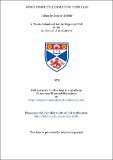Files in this item
Inner product quadrature formulas
Item metadata
| dc.contributor.advisor | Phillips, G. M. (George McArtney) | |
| dc.contributor.author | Gribble, Julian de Gruchy | |
| dc.coverage.spatial | v, 241 p. | en_US |
| dc.date.accessioned | 2018-06-06T14:25:33Z | |
| dc.date.available | 2018-06-06T14:25:33Z | |
| dc.date.issued | 1979 | |
| dc.identifier.uri | https://hdl.handle.net/10023/13780 | |
| dc.description.abstract | We investigate an approach to approximating the integral (0.1) ⨍[sub]R w(x)f(x)g(x)dx ≡ I (f;g), where R is a region in one-dimensional Euclidean space, and w a weight function. Since (0.1) may be regarded as a continuous bi-linear functional in f and g we approximate it by a discrete bi-linear functional, which we term an Inner Product Quadrature Formula (I.P.Q.F.). (0.2) Q(f;g) ≡ f̲ᵀAg̲, Where f̲ᵀ = (Sₒ(f), . . . , s[sub]m(f))ᵀ g̲ᵀ = (Tₒ(g), . . . , T[sub]n(g)) ᵀ A = (aᵢ[sub]j)ᵐi=o,ⁿj=0, And a[sub]i[sub]j are real numbers, 𝛴 ᵐi=0 𝛴ⁿj =0 |aᵢ [sub]j | > 0 The so-called elementary functionals {Sᵢ}ᵐi=0 and {T[sub]j}ⁿj=0 are two sets of linearly independent linear functionals, acting f and g respectively, defined over a certain subspace of functions to which f and g belong. The simplest example of these functionals is function evaluation at a given point. The matrix A is determined by requiring (0.2) to be exact for certain classes of functions f and g, say F𝜀𝛷𝛾 ≡ {𝛷₀, . . . , 𝛷ᵧ}, 𝛾≥0 G𝜀𝛹𝛿 ≡ {𝛹₀, . . . , 𝛹[sub] 𝛿} 𝛿≥0 In Chapter 1 we introduce the concept of I.P.Q.F. in more detail and make some general comments about approaches available when examining numerical integration. After explaining in some detail why we feel I.P.Q.F. are a useful tool in §2.1, we proceed in the remainder of Chapter 2 to investigate various conditions which may be placed on 𝛷ᵞ, 𝛹[super] 𝛿 {Sᵢ}ᵐi=0 and {T[sub]j}ⁿj=0 in order to guarantee the existence of I.P.Q.F. exact when F𝜀𝛷𝛾 and G𝜀𝛹𝛿. In particular we investigate the question of maximizing 𝛾+ 𝛿. In the case where 𝛷ᵢ and 𝛹[sub]j are the standard monomials of degree i and j respectively, some results have already been published in B.I.T. (1977) p. 392-408. We investigate various choices of 𝛷ᵢ and 𝛹[sub]j : (a) {𝛷ᵢ}ᵐ⁺¹ I = 0 (i.e. 𝛾 = m+1) and {𝛹[sub]j}ᵐ[sub]j = 0 (i.e. 𝛿 = m) being Tchebychev sets (§2.7), (b) {𝛷ᵢ}²ᵐ⁺¹ I = 0 (i.e. 𝛾 = 2m+1) being a Tchebychev set and 𝛹[super]𝛿 contains only one function (i.e. 𝛿 = 0) (§2.6) (c) 𝛷ᵢ ≡ (𝛷[sub]l)ⁱ, i=0,1, . . . and 𝛷ᵢ = 𝛹ᵢ, i= 0, 1, … (§2.8). In Chapter 3 we consider the question of compounding I.P.Q.F. both in the classical sense, and, briefly, by examining spline functions, regarding them as providing a link between an I.P.Q.F on one hand and a compounded I.P.Q.F. on the other. Various methods of theoretically estimating the errors involved are considered in Chapter M-. In the fifth Chapter we examine various ways in which the concept of I.P.Q.F. might (or might not) be extended. Finally, we make some brief comments about the possible applications of I.P.Q.F., and give a few examples. | en_US |
| dc.language.iso | en | en_US |
| dc.publisher | University of St Andrews | en |
| dc.subject.lcc | QA299.4I7G8 | |
| dc.subject.lcsh | Gaussian quadrature formulas | en |
| dc.title | Inner product quadrature formulas | en_US |
| dc.type | Thesis | en_US |
| dc.contributor.sponsor | University of St Andrews | en_US |
| dc.type.qualificationlevel | Doctoral | en_US |
| dc.type.qualificationname | PhD Doctor of Philosophy | en_US |
| dc.publisher.institution | The University of St Andrews | en_US |
This item appears in the following Collection(s)
Items in the St Andrews Research Repository are protected by copyright, with all rights reserved, unless otherwise indicated.

